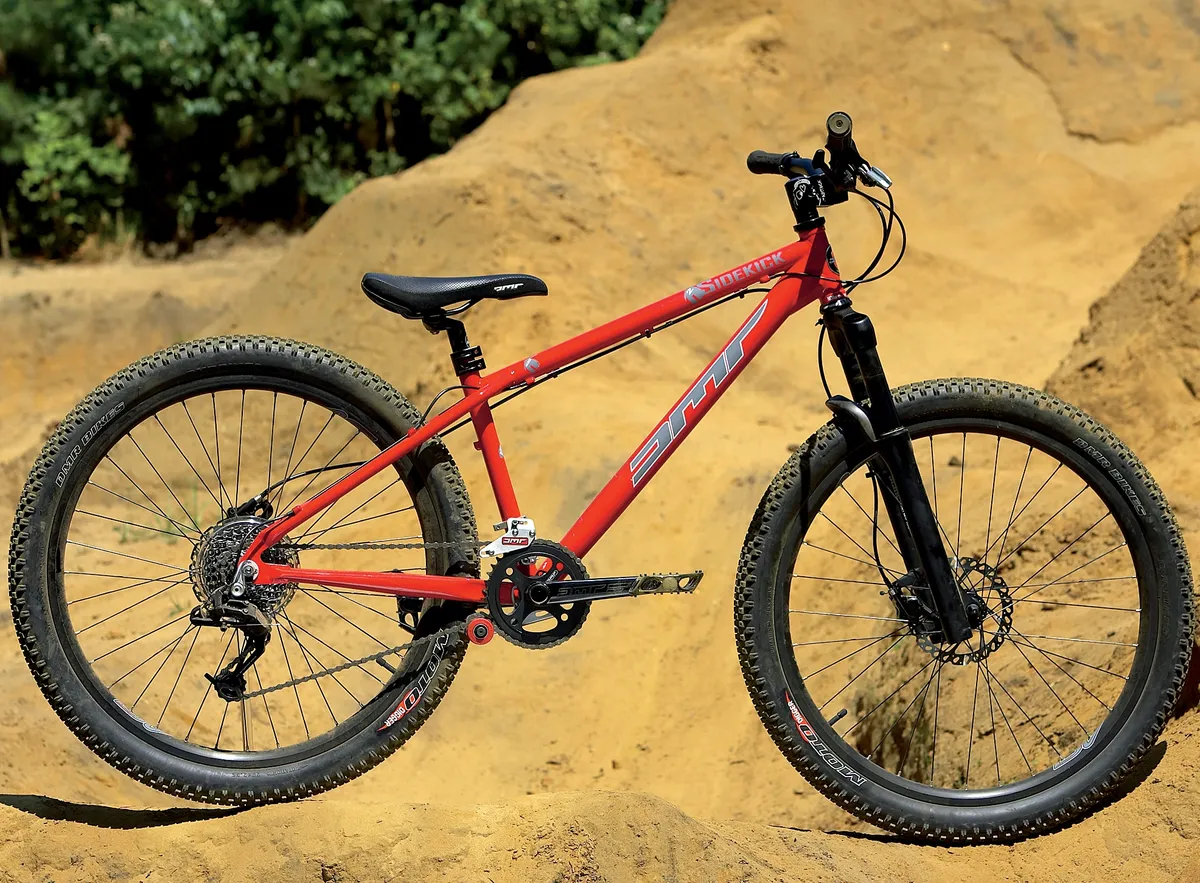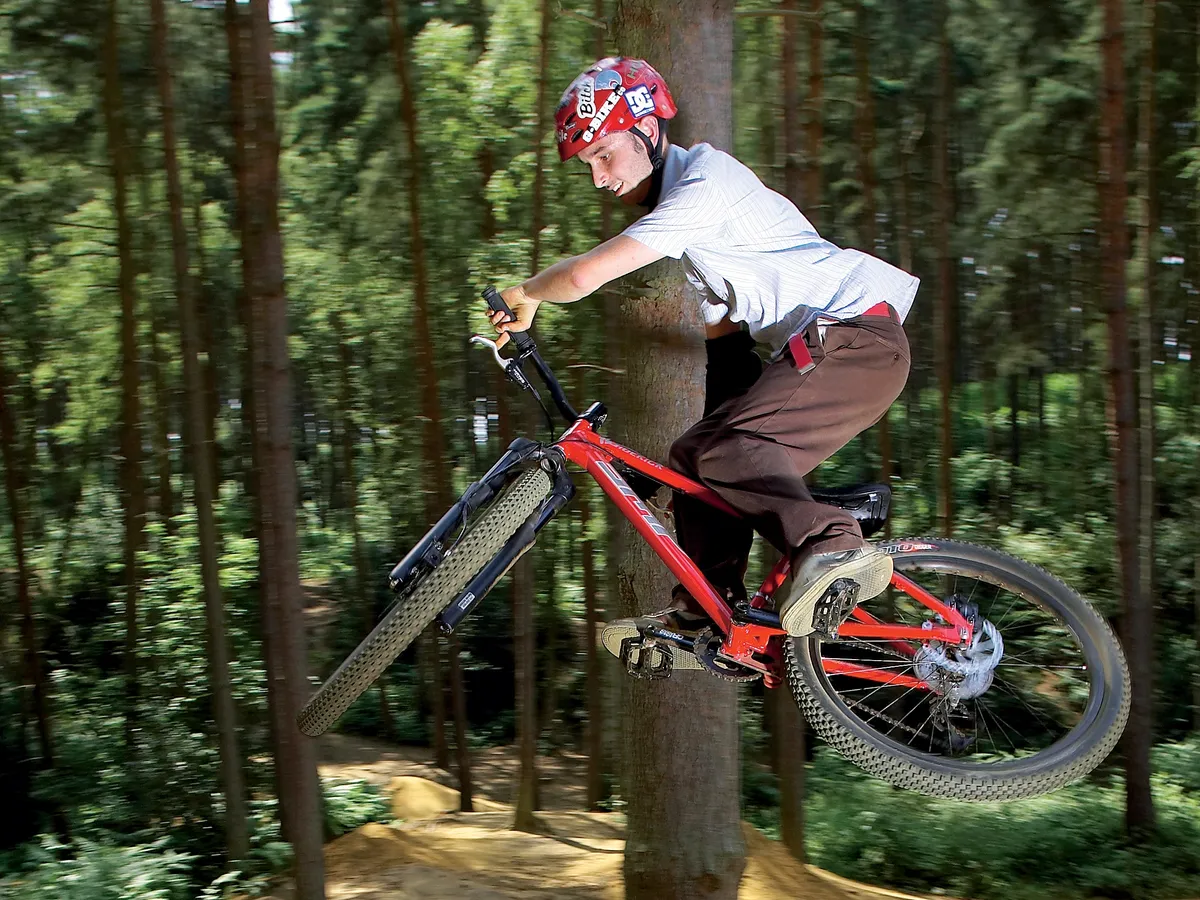Developed as the little brother to DMR's legendary Trailstar, the 26in-wheeled Sidekick has become a fully fledged jump and BSX beast in its own right, and now there's a second, lower priced, incarnation available.
Frame
The steel Sidekick frame has a few changes up front - the ring-reinforced 'no flare' head tube now features a big gusset filling the gap between the high-set down tube and the bottom of the head tube. The down tube itself is oversized at the top end too.
Our bike came with a standard bottom bracket shell with built-in ISCG chain device mounts, but you can also get the frame with a BMX style bottom bracket shell. The Sidekick is unique in this test for having vertical, single-position dropouts though, which means you'll need a chain tensioner if you want to run the bike singlespeed. It's also a dedicated 26in wheeled rig, with the DMR Rhythm serving as the purposebuilt 24in-wheeled singlespeeder.
As you'd expect for a bigger wheeled bike, it's relatively long at the back end. The top tube reach is also noticeably longer than on the 24seven or the Flow, although the relatively steep seat tube pushes your weight forward for easy balance.
DMR's long experience shows in the detailing of the frame. The complete bike is equipped with disc brakes front and rear, so the frame doesn't have V-brake studs (although the standalone frameset does). The almost parallel top tube and seatstay set-up looks very neat, with a broad bracing pipe straddling the seatstays just behind the seat tube. A doublebolted collar keeps the seat locked into position, but there's enough post to let you pull it up to crosscountry pedalling height for riding to the woods or even tackling the odd singletrack loop.
Equipment
DMR also exploit this versatility in the bike's build. For a start, it's the only one here with gears, which immediately makes it more BSX/ cross-country/general ride friendly. The impressively silent running DMR Chain Cage and Chain Reactor chain guides mean there's no danger of dropping out of gear, although they do add a bit of weight and mean potentially more expensive crash damage compared to a singlespeed set-up.
DMR's higher budget also lets them fit a much smoother, quieter and far more controlled fork than on the other bikes here, in the shape of Manitou's Stance Static. The DMR crankset, stem and Revolver DV wheelset are all top quality too, and the Moto Digger tyres are classic dirt trail rubber.
Everyone who rode the bike wanted to saw the wide DMR Wingbar handlebar down straight away, but that's not much of an issue. The full set of Hayes hydraulic discs also got big rounds of applause from all the testers for their decisive and powerful performance. Reasonable weight despite gears, chainguide and bigger wheels helps boost the bike's overall agility too.
Ride
The biggest divider on performance, however, was the 26in wheel size - the overall performance compared to the 24in-wheeled bikes was much more stable on the ground but correspondingly difficult to work with in tight situations. Riders used to smaller wheels also felt they were loose and wobbly on landing. The 26in wheels definitely add more versatility in terms of getting up to speed faster and wider tyre choice.
To DMR's credit, the Sidekick is also surprisingly chuckable and agile once you get the wheels off the ground, and our test crew had no trouble throwing it around. We also tested a 24in version of the same bike, and it's clear that the frame offers a very tight feeling and responsive ride. Confidence is also increased by a great weight balance between the wheels, and the bike has a naturally forgiving and easy flying feel from take-off to touchdown. For riders who are really into their whips and similar tricks, the more compact Rhythm bike is a better ride.
The bottom line is that DMR's Sidekick 2 is a classic dirt bike, but in the company of a 24inwheeled singlespeed rig it feels baggier and more cumbersome on the ground. Launch speeds are actually higher though, which is great if you're a big air fan, and DMR's honed geometry means the bigger wheels don't spoil the agility when you're airborne. The gears, smooth fork and 26in wheels add a massive versatility boost to the bike, so if jumping is just part of your life - not all of it - this is the obvious choice.






